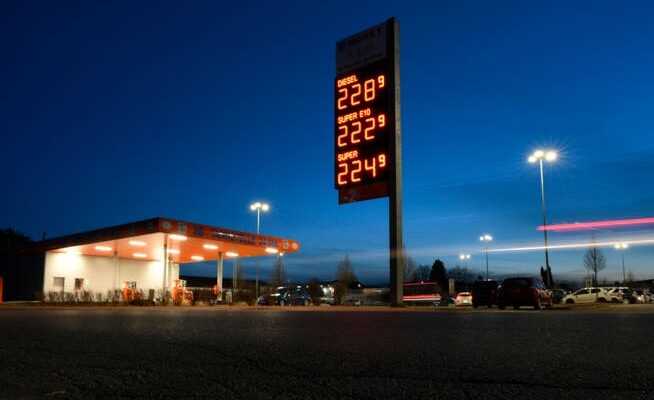The immense price increases are now spilling over into almost all areas of daily life. Inflation has also reached food through increased producer and wholesale prices. The price increase for fuel is also very strong.
Petrol and diesel prices recently reached new highs at petrol stations in Germany.
In Germany, most prices currently only know one direction: steeply upwards. On the other hand, only the earlier records tumble. The development concerns energy in particular. Fuel prices at gas stations are According to the Federal Statistical Office (Destatis), it has recently risen even faster than during the two oil crises in 1973/74 and 1979/80 and during the financial market crisis of 2008/09. In the 1970s in particular, inflation was as rampant as it is today.
Doubling of the price of heating oil
The dynamic development of energy prices due to the fading of the corona pandemic has again increased significantly as a result of Russia’s attack on Ukraine. In March, customers at German gas stations had to pay an average of 47 percent more than in the same month last year. The price increase for diesel, at 63 percent, was even greater than that for premium petrol, at 42 percent.
Consumers even had to pay almost two and a half times as much (144 percent more) for light heating oil as in March 2021. The explosion in fuel prices means that German politicians are constantly discussing possible financial relief for consumers who are particularly hard hit by this development is discussed. The European Central Bank (ECB), on the other hand, has so far hardly reacted to the high inflation rates.
A similarly strong increase in the price of imports of oil only occurred during the oil crises around 50 and 40 years ago. In November 1973, oil import prices had risen by almost 42 percent. A month earlier, the Yom Kippur War had begun, as a result of which the oil-exporting countries organized in the OPEC cartel reduced their output in order to put pressure on Western countries.
In March 1974, imported oil was more than three times as expensive as a year earlier. However, this increase did not have a full impact on petrol prices, as fuel prices increased by just under 33 percent compared to the previous year.
In the years 1979/80, according to Destatis, fuel prices rose by 28 percent within a year. The second oil crisis was mainly triggered by production shortfalls in connection with the Islamic Revolution in Iran in January 1979 and the First Gulf War, which began in September 1980.
At that time, natural gas prices followed those of oil with a certain lag. It’s different this time. Due to the high dependency on Russian natural gas, natural gas prices in Europe have risen faster and significantly more than oil prices. Prices for imported natural gas in February were almost 260 percent higher than in the same month of the previous year – a price increase that has probably never been seen before.
Price increases reach groceries
Massive inflation is now evident across the board. Producer prices for industrial products shot up by an average of 31 percent in March. That was the strongest increase since the survey began in 1949. Producer prices are the prices that manufacturers charge for their products, for example a farmer for his potatoes. Observers expect that retailers will pass on at least part of the price increases to consumers.
This will additionally drive the inflation rate. According to the European calculation method, the Inflation in Germany in March at 7.6 percent, in the entire euro zone at 7.5 percent. Energy was the main driver of producer prices. But the prices for metals or packaging made of wood also increased by 40 percent and almost 70 percent. The cost of vegetable oil even increased by more than 70 percent.
Wholesale prices are also skyrocketing. They reflect the cost of a good when it is sold in bulk to larger groups or traders. In March, wholesale prices rose by almost 23 percent, which was also the largest increase since calculations began in 1962.
The outbreak of war in Ukraine is already reflected in both producer and wholesale prices. In addition, there were also the consequences of disrupted supply chains, for example new outbreaks of the corona virus in China and the subsequent closures of ports or production plants. Due to the global situation, companies can currently pass on the higher prices more easily than a year ago, despite competition.
A mix of different causes
The strong currency depreciation is now also reflected in the considerably increasing prices for everyday goods and, above all, food. The prices for tomatoes (44 percent), cucumbers (40 percent), sunflower oil (30 percent) and frozen food (22 percent) rose massively in March compared to the same month last year. Potatoes, butter, pasta, eggs, bean coffee and numerous other products also saw double-digit price increases of between ten and twenty percent. Total food costs rose 6.2 percent in March.
The causes for this are usually a mixture of higher energy and transport costs, more expensive raw materials, logistics problems and the consequences of the war in Ukraine. The latter is considered the granary of Europe. But Russia is also a major exporter of wheat, although it has banned exports until the end of June. Due to the unfavorable situation, economists expect that the rise in inflation will continue for the time being, before the prices for oil and natural gas, which have meanwhile fallen again, have an impact on the prices for processed products and other goods.
You can contact business editor Michael Rasch Twitter, linkedin and Xing and NZZ Frankfurt Facebook follow.
